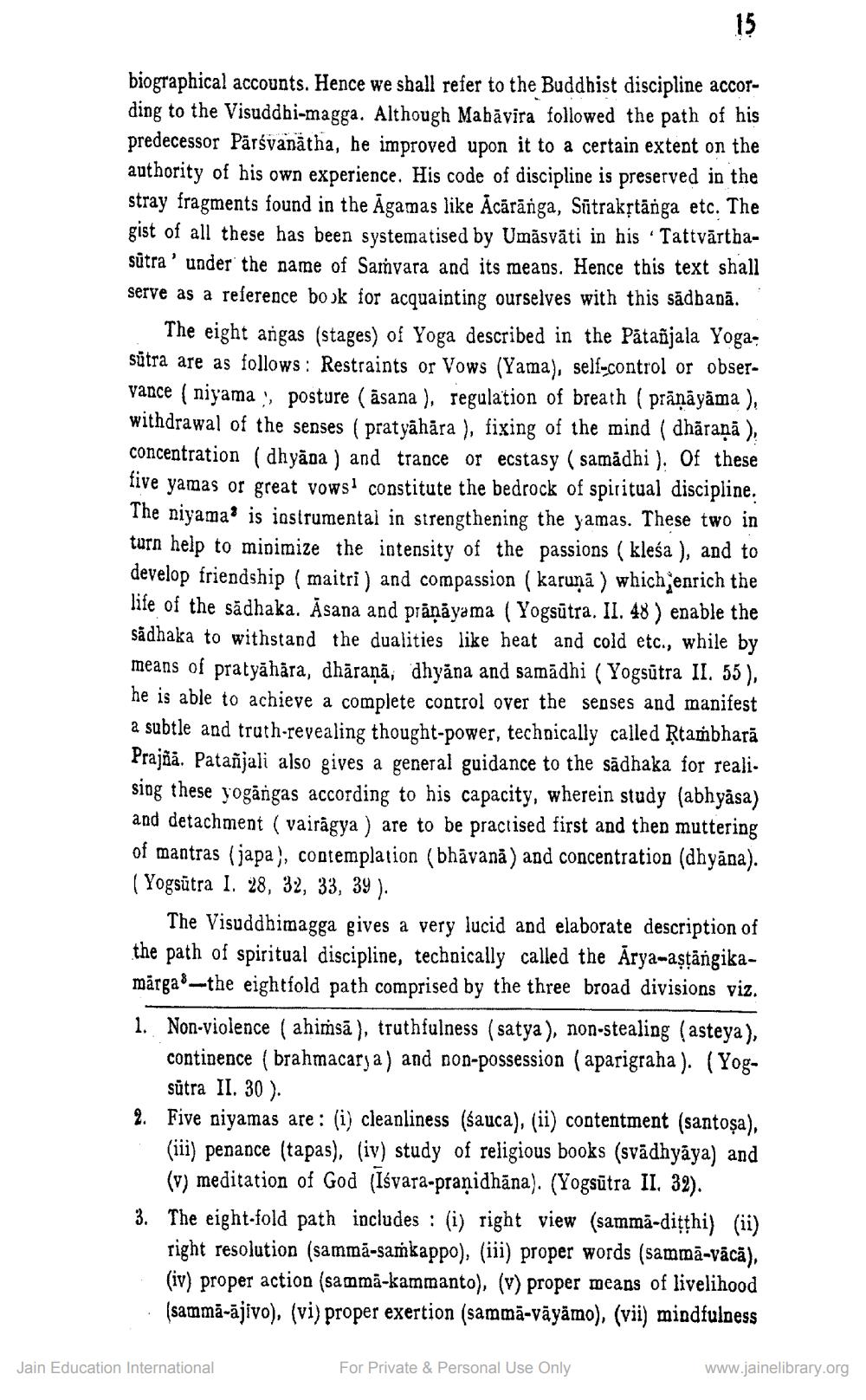________________
biographical accounts. Hence we shall refer to the Buddhist discipline according to the Visuddbi-magga. Although Mabāvira followed the path of his predecessor Pārsvanātha, he improved upon it to a certain extent on the authority of his own experience. His code of discipline is preserved in the stray fragments found in the Agamas like Ācārānga, Sūtrakstānga etc. The gist of all these has been systematised by Umāsvāti in his Tattvärthasūtra' under the name of Samvara and its means. Hence this text shall serve as a reference book for acquainting ourselves with this sādbanā.
The eight angas (stages) of Yoga described in the Patañjala Yogasütra are as follows: Restraints or Vows (Yama), self-control or obseryance ( niyama ', posture (asana), regulation of breath ( prāņāyāma ), withdrawal of the senses ( pratyāhāra ), fixing of the mind ( dhäraņā ), concentration (dhyāna ) and trance or ecstasy (samadhi). Of these five yamas or great vows' constitute the bedrock of spiritual discipline. The niyama' is instrumentai in strengthening the yamas. These two in turn help to minimize the intensity of the passions ( kleśa ), and to develop friendship (maitri) and compassion ( karunā ) which enrich the life of the sädhaka. Āsana and pràņāyama ( Yogsūtra. II. 48 ) enable the sädhaka to withstand the dualities like heat and cold etc., while by means of pratyāhāra, dhāraṇā, dhyāna and samādhi ( Yogsūtra II. 55), he is able to achieve a complete control over the senses and manifest a subtle and truth-revealing thought-power, technically called ştambharā Prajñā. Patañjali also gives a general guidance to the sādhaka for reali. sing these yogāngas according to his capacity, wherein study (abhyasa) and detachment (vairágya ) are to be practised first and then muttering of mantras (japa), contemplation (bhāvanā) and concentration (dhyāna). ( Yogsūtra 1. 28, 32, 33, 39).
The Visuddhimagga gives a very lucid and elaborate description of the path of spiritual discipline, technically called the Ārya-așțängikamärga8-the eightíold path comprised by the three broad divisions viz. 1. Non-violence ( ahimsā), truthfulness (satya), non-stealing (asteya),
continence (brahmacarya) and pon-possession (aparigraha). (Yog
sūtra II. 30 ). 2. Five niyamas are: (i) cleanliness (sauca), (ii) contentment (santoșa),
(iii) penance (tapas), (iv) study of religious books (svādhyāya) and
(v) meditation of God (Isvara-pranidhāna). (Yogsūtra II, 32). 3. The eight-fold path includes : (i) right view (sammā-dithi) (ii)
right resolution (sammā-saṁkappo), (iii) proper words (sammā-vācā), (iv) proper action (sammā-kammanto), (v) proper means of livelihood (sammā-ājivo), (vi) proper exertion (sammā-vāyāmo), (vii) mindfulness
Jain Education International
For Private & Personal Use Only
www.jainelibrary.org




